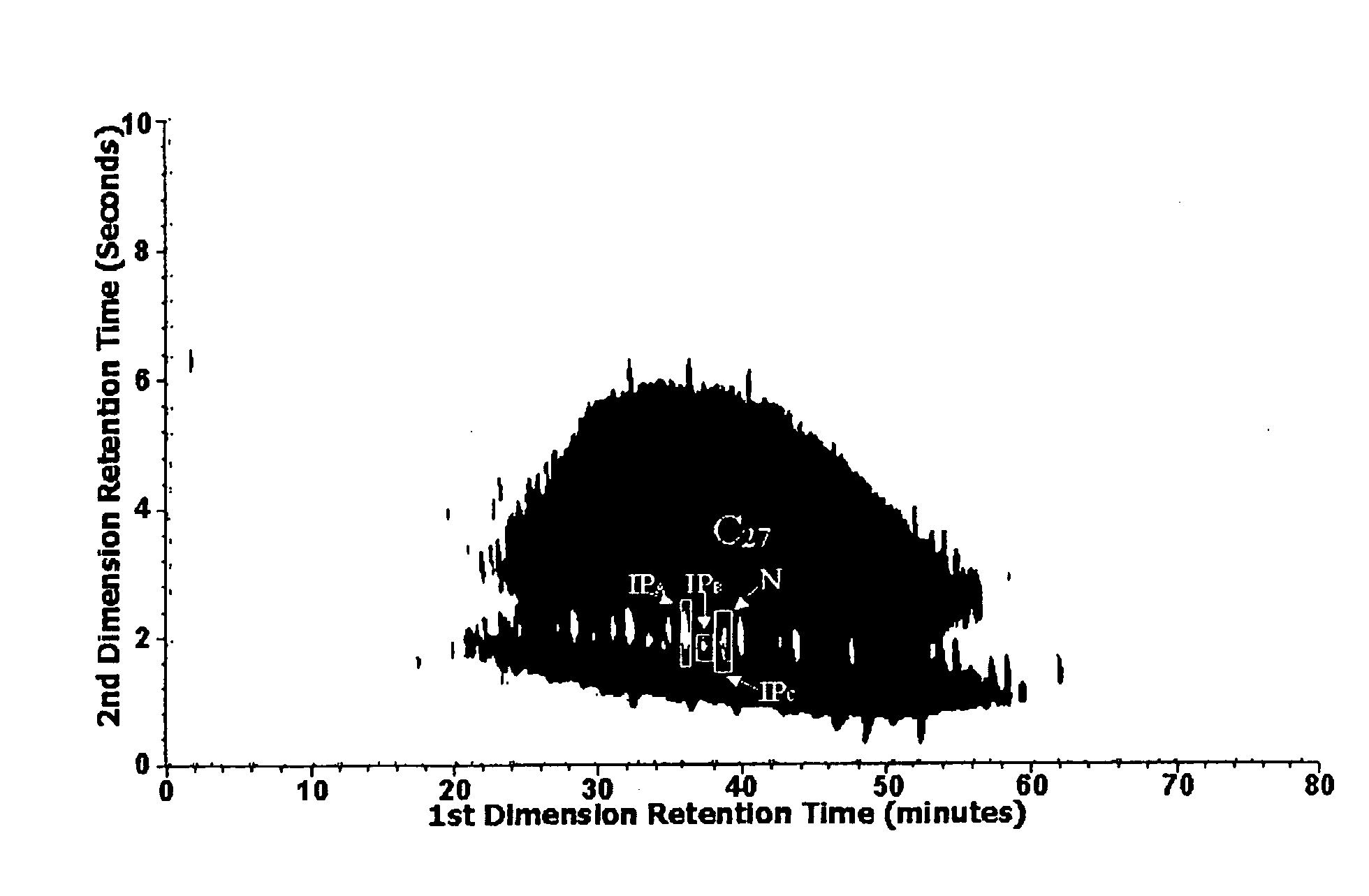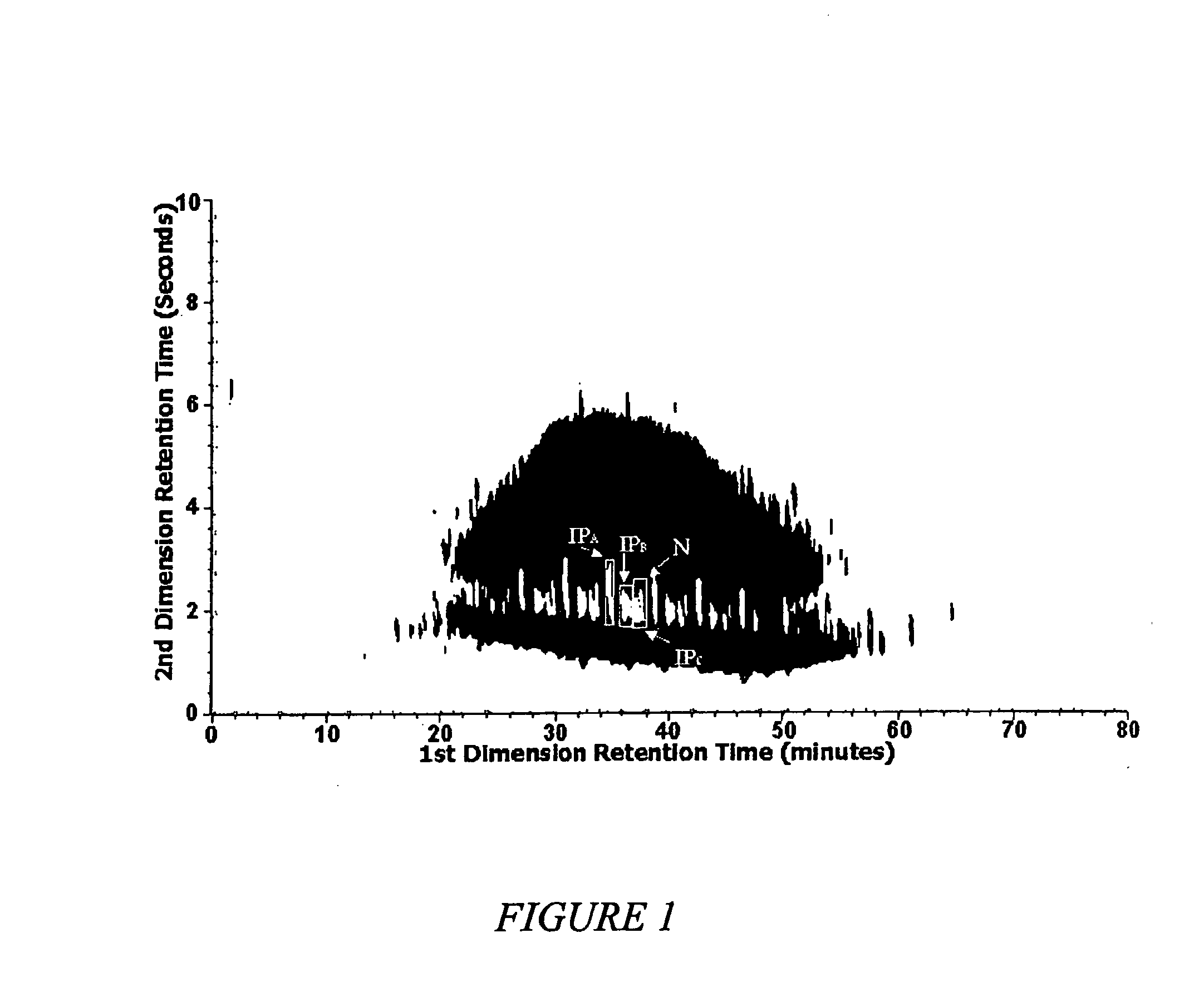Method of Analyzing Basestocks for Low Temperature Properties
a technology of lubricating oil and low temperature properties, which is applied in the direction of hydrocarbon oil treatment products, instruments, testing food, etc., can solve the problems of ineffectiveness in one direction, deterioration of low temperature properties, and not necessarily providing information as to the compositional characteristics of that oil
- Summary
- Abstract
- Description
- Claims
- Application Information
AI Technical Summary
Benefits of technology
Problems solved by technology
Method used
Image
Examples
example 1
[0065]A commercially solvent dewaxed basestock was used as the feed in trim dewaxing (SDW followed by HDW) experiments. The commercial basestock is a mixture of light basestock at approximately 81 wt % and medium basestock at approximately 19 wt %. A 130N lube raffinate was used as the feed in the two combined dewaxing schemes. The basestock properties are summarized in Table 2.
TABLE 2Commercial Basestock and 130N Raffinate PropertiesCommercial130N LubeFeed DescriptionbasestockRaffinateSample Used in Pilot Unit / Trim HDWSDW −> HDWRunHDW −> SDWCloud Point (° C.)—35.6Pour Point (° C.)−1831Density @ 15° C. (g / cc)0.8440.8332Sulfur (wppm)Nitrogen (wppm)Color (Lovibond Saybolt)>+30>+30RI @ 75° C.—1.4401KV @ 40° C. (cSt)23.316.910KV @ 100° C. (cSt)4.63.972VI114135.1Wax Content (%)—25.3MRV (cP)36211—
example 2
[0066]All HDW work in three process methods used commercially available Pt / ZSM-48 as the dewaxing catalyst. The commercial 1 / 16″ quadrulobe extrudates contain 65% ZSM-48 crystals bound with 35% alumina. Platinum was impregnated onto the extrudates using platinum tetraammine nitrate.
HDW Procedure
[0067]The HDW studies were performed using a continuous catalyst testing unit, which consists of a liquid feed system with an ISCO syringe pump, a fixed-bed tubular reactor with a three-zone furnace, liquid product collection, and an on-line MTI GC for gas analysis. Typically, 5-10 cc of catalyst was sized to 14 / 20 mesh and charged in an up-flow ⅜″stainless steel reactor containing a ⅛″ thermowell. After the unit was pressure tested, the catalyst was dried at 300° C. for 2 hours with 250 cc / min N2 at ambient pressure. If pre-sulfidation of the catalyst was required, 2% H2S in hydrogen was flowed through the catalyst bed at 100 sccm for 1 hour. Upon completion of the catalyst treatment, the re...
example 3
2D GC Measurement of Baseoil Composition
[0071]The 2D GC (GC×GC) system consists of an Agilent 6890 gas chromatograph (Agilent Technology, Wilmington, DE) configured with inlet, columns, and detectors. A split / splitless inlet system with an eight-vial tray autosampler was used. The two-dimensional capillary column system utilizes a non-polar first column (BPX-5, 30 meter, 0.25 mm I.D., 1.0 μm film), and a polar (BPX-50, 9 meter, 0.25 mm I.D., 0.25 μm film), second column. Both capillary columns are the products of SGE Inc. Austin, Tex. A dual jet thermal modulation assembly based on Zoex technology (Zoex Corp. Lincoln, Neb.) which is liquid nitrogen cooled “trap-release” dual jet thermal modulator is installed between these two columns. A flame ionization detector (FID) is used for the signal detection. A 0.2 microliter sample was injected with 75:1 split at 300° C. from Inlet. Carrier gas is programmed from 1.5 ml / min with 0 minute hold and 0.05 ml / min per minute increment to 5.0 ml...
PUM
| Property | Measurement | Unit |
|---|---|---|
| pressures | aaaaa | aaaaa |
| temperatures | aaaaa | aaaaa |
| partial pressure | aaaaa | aaaaa |
Abstract
Description
Claims
Application Information
 Login to View More
Login to View More - R&D
- Intellectual Property
- Life Sciences
- Materials
- Tech Scout
- Unparalleled Data Quality
- Higher Quality Content
- 60% Fewer Hallucinations
Browse by: Latest US Patents, China's latest patents, Technical Efficacy Thesaurus, Application Domain, Technology Topic, Popular Technical Reports.
© 2025 PatSnap. All rights reserved.Legal|Privacy policy|Modern Slavery Act Transparency Statement|Sitemap|About US| Contact US: help@patsnap.com



